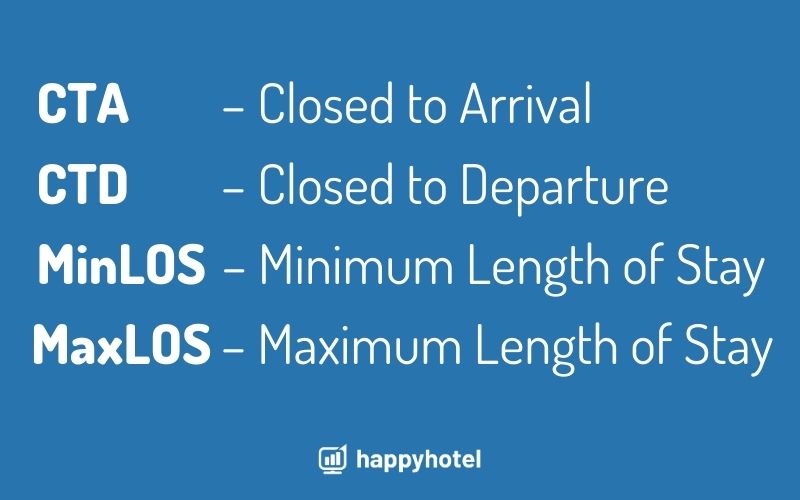Restrictions are a tool to influence the occupancy rate and the room rate in your hotel.
- Definition of hotel restrictions – what are they?
- Types of restrictions for hotels – what are the possibilities?
- CTA – Closed to Arrival
- CTD – Closed to Departure
- MinLos – Minimum Length of Stay
- MaxLos – Maximum Length of Stay
- Use of restrictions in hotels – example
Definition of hotel restrictions – what are they?
Restrictions are also called stay conditions or stay controls. Their purpose is to achieve optimal occupancy in the hotel with as few gaps in occupancy as possible.
Many of the practices were first used with airlines and then adopted for hotels. They need to be carefully considered and adapted to the requirements of one’s own hotel.
The most common restrictions applied are arrival/departure and length of stay. They are usually used on a certain number of rooms or/and at a certain time.
Restrictions on length of stay are probably the most common and most appropriate way to increase the occupancy and revenue of your hotel.
Types of restrictions for hotels – what are the possibilities?
We explain the four most common stay controls here: CTA, CTD, MinLOS, MaxLOS
CTA – Closed to Arrival
CTA is an availability block: Your guests cannot arrive on a particular day. The rooms blocked in this way cannot be booked for an arrival. Guests who have arrived before this date can stay in the hotel beyond this specific date.
Please keep in mind that someone who arrives on this day and wants to stay several nights (at a good room rate) cannot book – because exactly his arrival date is not available.
This restriction is often used for arrangements and cheaper rates. This practice is also known from holiday destinations: Arrivals are not possible on weekdays, only from Sunday to Sunday, at least at certain prices.
CTD – Closed to Departure
You can use this tool to block rooms for departure on a specific day. Your guests cannot depart on this day (but they can arrive, of course). The restriction has no influence on stays with previous arrival and overnight stays beyond this day.
The possible uses for this restriction are limited. For example, it can be used to ensure that holiday guests do not extend a one-week stay by one or two nights and thus hinder the optimal occupancy of the rooms.
MinLOS – Minimum Length of Stay
You give your guests a minimum number of nights they have to book if they want to check in on a certain day. You may want to link this to a specific rate.
This can be useful if the demand for rooms is very high in a certain period. Then you can avoid a lot of shorter stays, which may also mean empty rooms. However, it should not be forgotten that walk-ins and shorter stays (at higher rates) actually mean profit for your hotel.
This tool can generally also be used to increase occupancy rates in low occupancy periods – if enough guests can be found to accept the minimum stay.
MaxLOS- Maximum Length of Stay
Here you set the maximum length of stay for which a guest can book at a certain (usually low) rate. Long stays can thus be avoided during trade fairs.
This way you can control your occupancy at short notice: There is a 2-day congress and you have booked all rooms at that time. Then the restriction can help you to get bookings for the day before. These are then (MaxLOS = 1) limited to one night, so that all rooms are available again on the congress days.

Use of Restrictions with Hotels – Example
When using stay controls, you should pay attention to the booking patterns. If you own a business hotel, it will make little sense to block Fridays for departures. On the other hand, if you own a holiday hotel, minimum stay conditions may be an option to increase occupancy.
Most of the time it will be worthwhile to apply restrictions not to your entire hotel, but to certain rates or rooms at selected times. This way you can ensure that the requirements of different guests are taken into account. This will increase your occupancy rate and, if you use the restrictions wisely, your room rates as well.
If your hotel is fully booked from Friday to Sunday due to a big event in your city, you can apply the restriction MaxLOS to the rooms that are still available from Thursday to Friday. Combined with a special price for these bookings, you will achieve optimal occupancy and room occupancy.
